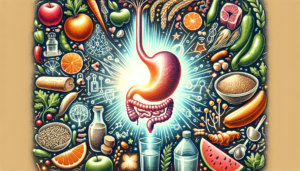A Comprehensive Guide to Nutrient Rich Diets
Understanding Nutrient-Rich Diets
A nutrient-rich diet prioritizes foods that provide a high amount of vitamins, minerals, and other essential nutrients relative to their calorie content. This type of diet emphasizes whole, unprocessed foods, which are often more beneficial for overall health compared to calorie-dense, nutrient-poor options. Understanding the components of a nutrient-rich diet can help individuals make informed dietary choices that support long-term health.
The Importance of Nutrient Density
Definition of Nutrient Density
Nutrient density refers to the ratio of nutrients to calories in a food item. Foods that are nutrient-dense provide more vitamins and minerals per calorie. For instance, vegetables, fruits, whole grains, lean proteins, and healthy fats are typically considered nutrient-dense foods.
Benefits of Nutrient-Dense Eating
- Weight Management: Nutrient-rich foods are often lower in calories, making it easier to maintain a healthy weight.
- Disease Prevention: Diets rich in nutrients can lower the risk of chronic diseases such as heart disease, diabetes, and certain cancers.
- Improved Energy Levels: Consuming nutrient-dense foods can help boost energy levels due to the optimal functioning of the body’s metabolic processes.
- Enhanced Mood: Nutrient-rich diets are linked to improved mental health outcomes.
Key Components of a Nutrient-Rich Diet
Fruits and Vegetables
Fruits and vegetables are the cornerstone of any nutrient-rich diet due to their high content of vitamins, minerals, fiber, and antioxidants.
- Variety is Key: Aim for a rainbow of colors to ensure a wide range of nutrients. For example, red peppers are high in vitamin C, while leafy greens like spinach provide iron and calcium.
- Fresh, Frozen, or Canned: Fresh is often best, but frozen and canned options can be equally nutritious if they are prepared without added sugars or salt.
Whole Grains
Whole grains are an essential source of complex carbohydrates, fiber, B vitamins, and various minerals.
- Examples of Whole Grains: Brown rice, quinoa, oats, barley, and whole-wheat products.
- Benefits: Whole grains can help regulate blood sugar levels, improve digestion, and provide sustained energy.
Lean Proteins
Incorporating lean proteins into the diet is essential for muscle repair, hormone production, and overall body function.
- Sources of Lean Protein: Skinless poultry, fish, legumes (beans and lentils), tofu, and low-fat dairy products.
- Vegetarian Options: Plant-based proteins can provide the necessary amino acids while also contributing fiber and other essential nutrients.
Healthy Fats
Contrary to popular belief, fats are a necessary component of a balanced diet. Healthy fats support brain health, hormone regulation, and the absorption of fat-soluble vitamins (A, D, E, K).
- Sources of Healthy Fats: Avocados, nuts, seeds, olive oil, and fatty fish (like salmon) rich in omega-3 fatty acids.
- Balanced Intake: Aim for unsaturated fats while limiting trans fats and saturated fats found in processed foods.
Building a Nutrient-Rich Plate
The Plate Method
The plate method is a practical visual tool to guide portion sizes and food groups in a nutrient-rich diet.
- Half the Plate: Fill half your plate with non-starchy vegetables and fruits.
- One Quarter: Allocate a quarter of your plate to lean proteins.
- One Quarter: Reserve the remaining quarter for whole grains.
Mindful Eating
Practicing mindfulness while eating can enhance the experience and help maintain a balanced diet.
- Slow Down: Take time to savor each bite, which can help you recognize when you are full.
- Limit Distractions: Eating without the distractions of electronic devices can foster a more enjoyable and healthy eating experience.
Common Misconceptions about Nutrient-Rich Diets
Myth: Nutrient-Dense Foods Are Expensive
While some whole foods (like exotic fruits and organic products) can be pricey, many nutrient-dense options, such as beans, rice, seasonal produce, and frozen vegetables, are cost-effective.
Myth: You Need Supplements
While supplements can help fill nutritional gaps, it is typically more beneficial to obtain nutrients from whole foods, where bioavailability and synergy among nutrients can enhance absorption and effectiveness.
Tips for Transitioning to a Nutrient-Rich Diet
Start Small
Begin by gradually introducing more nutrient-dense foods into your meals. For example, swap white rice for quinoa or choose whole grain bread instead of white bread.
Meal Planning
Planning meals in advance allows individuals to make more intentional choices about the foods they consume. Create a weekly menu that emphasizes fruits, vegetables, whole grains, and lean proteins to ensure balanced nutrition.
Pack Snacks
Choose nutrient-dense snacks to avoid unhealthy temptations. Consider options like raw nuts, yogurt with berries, or vegetable sticks with hummus.
Special Considerations for Nutrient-Rich Diets
Vegan and Vegetarian Diets
For those following plant-based diets, it’s crucial to pay extra attention to specific nutrients that might be less accessible. Nutrients such as vitamin B12, iron, and omega-3 fatty acids can require dietary adjustments or supplementation to ensure optimal health.
- Vitamin B12 Sources: Fortified nutritional yeast, fortified plant milks, and certain fortified cereals.
- Iron Sources: Lentils, chickpeas, quinoa, fortified cereals, and spinach can help meet iron needs, but consider pairing with vitamin C sources to enhance absorption.
- Omega-3 Fatty Acids: Algal oil supplements or ground flaxseed and chia seeds can serve as plant-based sources.
Health Conditions
Certain health conditions might require specific adjustments when following a nutrient-rich diet. Always consult with a healthcare professional or registered dietitian for personalized dietary advice.
- Diabetes: Focus on low glycemic index foods, such as whole grains and legumes, which can help regulate blood sugar levels.
- Heart Health: Incorporate foods high in fiber, antioxidants, and healthy fats while minimizing sodium and saturated fats.
Nutrient-Rich Diets Around the World
Mediterranean Diet
The Mediterranean diet emphasizes whole grains, fruits, vegetables, fish, olive oil, and moderate consumption of dairy. This approach has been linked to reduced risks of heart disease, stroke, and certain cancers.
Nordic Diet
Similar to the Mediterranean, the Nordic diet includes whole grains, fatty fish, root vegetables, and berries. It emphasizes seasonal and locally-sourced foods, promoting sustainability along with health.
Asian Diets
Many traditional Asian diets such as the Japanese and Chinese diets focus on rice, vegetables, fish, and fermented foods, highlighting nutrient-dense ingredients such as seaweed and soy products, which can contribute to longevity and reduced disease risk.
Tracking Nutrient Intake
Food Journals
Keeping a food journal can help individuals track their nutrient intake and make adjustments as necessary. Writing down meals can also identify patterns of unhealthy snacking or unbalanced meals.
Mobile Apps
Various mobile apps can assist individuals in monitoring their nutrient intake. Apps like MyFitnessPal and Cronometer allow users to log food items and analyze their nutrient content.
Encouraging Healthy Habits
Family Involvement
Encourage family members to participate in meal preparation and planning. This practice can instill valuable cooking skills and promote a collective commitment to healthy eating habits.
Cooking At Home
Preparing meals at home allows for greater control over ingredients and portion sizes. Experimenting with new recipes can make incorporating nutrient-dense foods enjoyable.
Community Engagement
Participating in community-supported agriculture (CSA) or local farmers’ markets can promote the consumption of fresh, local produce while supporting local farming ecosystems.
In summary, a comprehensive approach to a nutrient-rich diet not only focuses on the quality and diversity of food choices but also encourages mindfulness and intentionality in eating habits. This strategy contributes to improved overall health and well-being, making it a sustainable lifestyle choice for individuals and families alike.








